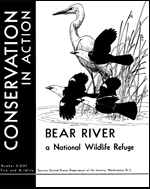United States Fish and Wildlife Service

United States Fish and Wildlife Service: Publications
Date of this Version
2002
Abstract
The endangered Wyoming toad (Bufo baxteri) is found only as a reintroduced population at Mortenson National Wildlife Refuge (NWR) in the Laramie Plains of southeast Wyoming. Reasons for the decline of this amphibian are unknown. Data on predation, habitat modification, soil and water conditions (Stone 1991), and water quality (Ramirez 1992; Ramirez and Armstrong 1992), are available; but, none of these parameters are documented as posing serious threats to the toad.
One threat that has not been investigated is the potential for agricultural fertilizers containing nitrates to enter surface water at Mortenson NWR. Nitrates are transported by irrigation runoff and snowmelt during the same time frame as the growth and development period of the Wyoming toad (Stone 1991); and, although little information exists on the effects of nitrates on amphibians, nitrates are suspected of playing a role in the decline of some amphibian populations. Hecnar (1995) suggests that nitrates may pose a risk to amphibians that is equivalent to that of pesticides.
The current water quality guideline for nitrates is 10 mg/L NO3-N (EPA 1986). This guideline is set to protect human health but is not protective of some amphibians species (Hecnar 1995). In acute toxicity tests with the American toad (B. americanus), chorus frog (Pseudacris triseriata), leopard frog (Rana pipiens), and green frog (R. clamitans) exposed to ammonium nitrate fertilizer, the amphibians exhibited reduced activity, weight loss, and physical abnormalities. The toxic effects were observed at “concentrations that are commonly exceeded in agricultural areas” (Hecnar 1995) and frequently occurred during the amphibian larvae development period (Berger 1989). Additionally, toad (Bufo spp.) tadpoles were more sensitive to nitrates than were water frogs (Rana spp.) (Berger 1989). When exposed to nitrates, the amphibians often showed a sluggish behavior or appeared somewhat paralyzed when prodded. This behavior impairs the ability of the tadpoles to acquire food or avoid predation (Hecnar 1995). Both of these activities can ultimately result in poor survivability and low reproductive success for the Wyoming toad.
The purpose of this study was to determine the concentrations of nitrates at Mortenson NWR and whether these concentrations are potentially affecting the survival of the Wyoming toad. Water samples were collected pre-, during, and post-irrigation at Mortenson NWR and submitted for general water quality analyses and analysis of nitrite, nitrate, and ammonia. Frog embryo teratogenesis assays, using Woodhouse’s toad (B. woodhousii) embryos as surrogates for the Wyoming toad, were conducted at the Midwest Science Center at Columbia, Missouri. Test solutions were prepared using a standard dilution series with one dilution representative of nitrate concentrations present in the field. Percent mortality, timing of metamorphosis, and presence of deformities were measured.
Survival and metamorphosis were significantly reduced by the ammonia nitrate concentrations at the two highest treatments tested in the assay. The treatment representative of ammonia nitrate concentrations found at Mortenson NWR did not impact tadpole survival or metamorphosis. Deformities in the tadpoles were observed in all treatments including controls. The deformities did not appear to be caused by the ammonia nitrate concentrations and may be the result of the tadpoles’ diet.
Results of this study show that ammonia nitrate concentrations are not currently elevated to concentrations that would adversely affect the Wyoming toad. Increases in nitrogen input, such as what might occur with changes in land use, could increase the risk for adverse affects to the toad, particularly because ammonia nitrate concentrations may act synergistically with other environmental factors or may serve as a stressor for increasing the toads’ susceptibility to disease. Periodical sampling of water from Mortenson NWR will ensure that nitrogen input does not increase to concentrations exceeding the tolerance level of Wyoming toads.


Comments
Published in Contaminant Report Number: R6/719C/02, 1-24, (2002)